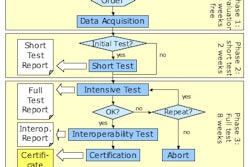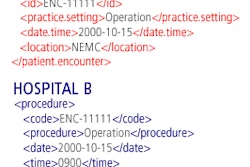NEW ORLEANS - Disruptive technologies tend to live up to their name -- by wreaking havoc on current systems and workflow. Diagnostic imaging has weathered two such products on the informatics front in recent years -- RIS, which has impacted the practice from patient scheduling to billing, and PACS, which is generally embraced by clinicians across the healthcare enterprise.
The electronic health record (EHR), as deployed to the physician practice, is a disruptive technology. As imaging system administrators remember, the road to adopting RIS and PACS was marked by detours, potholes, and speed bumps. According to Charles Parker and Susan Ordway from healthcare quality improvement organization Masspro of Waltham, MA, unless proper planning is done for EHR deployment in the physician practice, its implementation, too, will stall or fail.
"Small to mid-size practices of 10 or fewer physicians make up approximately 70% of the U.S. healthcare market, and this is the group that is furthest behind in the EHR adoption process" said Parker, Masspro's vice president and chief technology officer, during a presentation Monday at the Healthcare Information and Management Systems Society (HIMSS) conference.
Masspro has seen mixed success with EHR implementation in this market space, said Ordway, the group's information technology quality manager. Echoing the findings of many a RIS/PACS project manager, she noted two factors common to the practices that achieved rich results with these systems: a willingness to embrace change and perform the groundwork prior to deployment.
"The most successful practices (for EHR deployment) are those that spend time defining goals for the project, involve everyone in the process, and communicate early and often," she said.
Interestingly, given a background on the vendor side of the market, Ordway has come to believe that successfully implementing an EHR system and achieving its goals is not about a particular application selected for adoption by a practice.
The bells and whistles displayed in a software product today may weather as well as a mullet haircut; Ordway said that an EHR system's core functionality is pretty much the same across the industry. As such, she advised selecting a vendor on the basis of its track record, service, support, and capability to form a long-term partnership with the group.
As for the practice, nearly a decade of involvement with EHR implementations has given Ordway a clear sense of what it takes to achieve implementation success. The first step she recommended is a thorough assessment of the technical, leadership, cultural, and organizational readiness of the group in its current incarnation. Once this is completed, a practice will want to develop a project charter with measurable goals.
"If you can't state why you want to implement an EHR and your expected benefits, you should reconsider starting the project," Ordway noted.
The next step in the assessment process is to establish a budget for the project.
"It is important to include costs of hardware, software, interfaces, services, maintenance, and your own resources, who will be tasked with implementing and managing the system ongoing ... and this does not include the costs related to lost productivity in the first few weeks post go-live, which is typical in many situations," she noted.
Finally, as part of the assessment phase, a practice will need to determine the clinical and executive champion for the project. Each of these is necessary for the success of the project -- the clinical champion for the professional component of the group and the executive champion for the clerical and administrative staff.
Once the assessment phase has been completed, the planning phase can be engaged. This can easily be the lengthiest part of the process, as well as the most crucial for the long-term success of an EHR deployment. Each task process in the group should either be listed or flow mapped as part of the operational redesign from paper-based practice to EHRs.
Once this has been accomplished, the clinical and executive champions can begin to manage the necessary cultural changes. By communicating early and often what tasks will change with EHR adoption, and when the practice expects this to occur, resistance barriers to change can be worn down.
"A strong communication plan is absolutely critical," Ordway noted. Every stakeholder in the group needs to be aware of the project, its progress, and its expected impact on their area.
Ordway had two pieces of advice for groups planning EHR culture change. For imaging administrators who earned their stripes in RIS/PACS deployment, her counsel could come from their playbook.
"Start early," she said, "and communicate often. It's important that you do what you say you will when you said that you would."
By Jonathan S. Batchelor
AuntMinnie.com staff writer
February 27, 2007
Related Reading
U.S. takes steps to ramp up HIT efforts, February 23, 2007
Frost forecasts EHR, clinical trial application convergence, January 23, 2007
Security considerations in transmitting medical information, January 19, 2007
CCHIT releases interoperability test scripts, data files, January 5, 2007
Moving toward flexible healthcare data sharing, December 28, 2006
Copyright © 2007 AuntMinnie.com



















